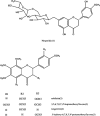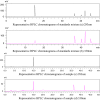Evaluation of chemical components in Citri Reticulatae Pericarpium of different cultivars collected from different regions by GC-MS and HPLC
- PMID: 29564108
- PMCID: PMC5849905
- DOI: 10.1002/fsn3.569
Evaluation of chemical components in Citri Reticulatae Pericarpium of different cultivars collected from different regions by GC-MS and HPLC
Abstract
To discriminate the feasible differences and find potential similarities and relationships of Citri Reticulatae Pericarpium (CRP), this work was accomplished by a comprehensive and reliable method using gas chromatography-mass spectrometer (GC-MS) to analyze the volatile oils and high-performance liquid chromatography (HPLC) simultaneously to determine the contents of five bioactive flavonoids, namely hesperidin, nobiletin, 3,5,6,7,8,3',4'-heptamethoxyflavone, tangeretin, and 5-hydroxy-6,7,8,3',4'-pentamethoxyflavone in 25 batches of CRP samples of 10 cultivars collected from different regions in China. The GC-MS analyses indicated that 98 compounds were successfully identified from the volatile oils obtained and the major constituents of volatile oil are d-limonene, γ-terpinene, α-pinene, linalool, and myrcene. Even 2-(methylamino) benzoate was found in all cultivar samples harvested at maturation stage. Under the optimal condition, the quantitative analyses of five bioactive flavonoids were successfully performed by HPLC and hierarchical cluster analysis (HCA). Results showed significant differences among cultivars in the contents of five bioactive flavonoids mentioned earlier. The HCA and GC-MS results provided a convenient approach which might be applied for rapid similarity evaluation and also holds the potential for analysis of compounds present in other plants. Therefore, this work obtained offers scientific basis to control quality and develop medicinal value of the medicinal materials in CRP.
Keywords: Citri Reticulatae Pericarpium; GC–MS; HPLC; cluster analysis; flavonoids; volatile oil.
Figures





Similar articles
-
[Prediction of Q-markers of Citri Reticulatae Pericarpium volatile oil and GC-MS based quantitative analysis].Zhongguo Zhong Yao Za Zhi. 2021 Dec;46(24):6403-6409. doi: 10.19540/j.cnki.cjcmm.20210924.302. Zhongguo Zhong Yao Za Zhi. 2021. PMID: 34994132 Chinese.
-
Identification of volatile and nonvolatile compounds in Citri Reticulatae Pericarpium Viride using GC-MS, UPLC-Q-Exactive Orbitrap-MS, and HPLC-PDA.Food Sci Nutr. 2023 Jan 4;11(3):1415-1425. doi: 10.1002/fsn3.3181. eCollection 2023 Mar. Food Sci Nutr. 2023. PMID: 36911822 Free PMC article.
-
Simultaneous determination of six bioactive flavonoids in Citri Reticulatae Pericarpium by rapid resolution liquid chromatography coupled with triple quadrupole electrospray tandem mass spectrometry.Food Chem. 2013 Dec 15;141(4):3977-83. doi: 10.1016/j.foodchem.2013.06.077. Epub 2013 Jun 27. Food Chem. 2013. PMID: 23993574
-
Citri Reticulatae Pericarpium (Chenpi): Botany, ethnopharmacology, phytochemistry, and pharmacology of a frequently used traditional Chinese medicine.J Ethnopharmacol. 2018 Jun 28;220:265-282. doi: 10.1016/j.jep.2018.03.031. Epub 2018 Apr 6. J Ethnopharmacol. 2018. PMID: 29628291 Review.
-
Progress of research on the role of active ingredients of Citri Reticulatae Pericarpium in liver injury.Phytomedicine. 2023 Jul;115:154836. doi: 10.1016/j.phymed.2023.154836. Epub 2023 Apr 18. Phytomedicine. 2023. PMID: 37119760 Review.
Cited by
-
Restoring trilinearity with the purpose of advanced modeling: towards a more effective analysis of Pericarpium Citri Reticulatae during storage periods.Heliyon. 2022 Mar 18;8(3):e09138. doi: 10.1016/j.heliyon.2022.e09138. eCollection 2022 Mar. Heliyon. 2022. PMID: 35345399 Free PMC article.
-
Transcriptome and Metabolome Analyses Provide Insights into the Flavonoid Accumulation in Peels of Citrus reticulata 'Chachi'.Molecules. 2022 Oct 1;27(19):6476. doi: 10.3390/molecules27196476. Molecules. 2022. PMID: 36235014 Free PMC article.
-
Valorization of Citrus Reticulata Peels for Flavonoids and Antioxidant Enhancement by Solid-State Fermentation Using Aspergillus niger CGMCC 3.6189.Molecules. 2022 Dec 15;27(24):8949. doi: 10.3390/molecules27248949. Molecules. 2022. PMID: 36558081 Free PMC article.
-
Nobiletin induces growth inhibition and apoptosis in human nasopharyngeal carcinoma C666-1 cells through regulating PARP-2/SIRT1/AMPK signaling pathway.Food Sci Nutr. 2019 Feb 10;7(3):1104-1112. doi: 10.1002/fsn3.953. eCollection 2019 Mar. Food Sci Nutr. 2019. PMID: 30918653 Free PMC article.
-
A novel method for the nondestructive classification of different-age Citri Reticulatae Pericarpium based on data combination technique.Food Sci Nutr. 2020 Dec 8;9(2):943-951. doi: 10.1002/fsn3.2059. eCollection 2021 Feb. Food Sci Nutr. 2020. PMID: 33598177 Free PMC article.
References
-
- Daniel, P. Bezerra , Emmanoel, V. Costa , & Paulo Cesar, L. Nogueira . (2013). Essential oil constituents: Biodiversity and their applicability for cancer therapy Antitumor potential and other emerging medicinal properties of natural compounds (pp. 285–300). Netherlands, Springer.
-
- Camarda, L. , Di Stefano, V. , Del Bosco, S. F. , & Schillaci, D. (2007). Antiproliferative activity of Citrus juices and HPLC evaluation of their flavonoid composition. Fitoterapia, 78, 426–429. - PubMed
-
- Careri, M. , Elviri, L. , Mangia, A. , & Musci, M. (2000). Spectrophotometric and coulometric detection in the high performance liquid chromatography of flavonoids and optimization of sample treatment for the determination of quercetin in orange juice. Journal of Chromatography A, 881, 449–460. - PubMed
-
- Chang, C. Y. , Lin, T. Y. , Lu, C. W. , Huang, S. K. , Wang, Y. C. , Chou, S. S. , Wang, S. J. (2015). Hesperidin inhibits glutamate release and exerts neuroprotection against excitotoxicity induced by kainic acid in the hippocampus of rats. Neurotoxicology, 50, 157–169. - PubMed
LinkOut - more resources
Full Text Sources
Other Literature Sources
Research Materials
Miscellaneous

